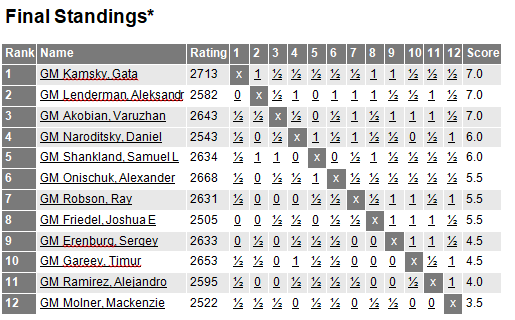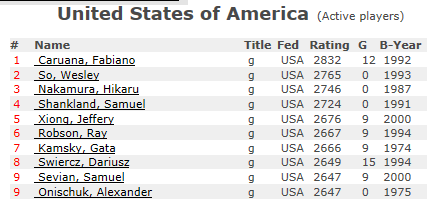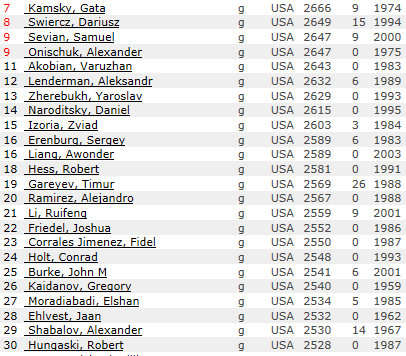Back in the early days of the Soviet Union preparing to become a true world power on the chess scene they made a change to their national championship format.
In 1929 for the first time there was not just an invited field. Instead, there were four preliminary groups which then became two Semi Finals where the top two finishers in each qualified for the double round robin final.
Over the years they refined this format and from this sprang the most dominant nation of all time. In fact Russia remains a powerhouse on the world chess scene, almost routinely churning out top 100 players, and in no small part I believe it’s due to the fact that remnants of this system remain today with the Higher League and Super Final which continue to give up and coming players chances to improve when they need it most.
Last summer I started mulling these concepts over in my mind to figure out if they could work here at home. I did this in anticipation of Dominguez making his federation switch, which has of course happened now.
Here’s what got me thinking. The current format in the US Championships, which has become more or less standard, is a 12 player round robin.
The first round robin championship I attended was 2014. For that tournament the players could qualify with a high 2500 FIDE rating.
Here is the final table:

The format for invites is that there are four automatic invites which go to the defending champion (Kamsky), the US Open Champion (Friedel), the US Junior Open Champion (Naroditsky), and a wild card (Molner).
The rest were invited by rating, so as you see 2582 (Lenderman) was good enough. Of course Hikaru turned down his invite so that has to be taken into consideration, but still, just five years ago the field was at this level.
Now let’s look at the top ten FIDE rated players in the US.

This is active players. Technically Dominguez isn’t active, so now you have to insert his name into this field and that means that we now have several players over 2600 (Akobian, Lenderman, Zherebukh, Naroditsky, and Izoria) who aren’t even on the radar.
And not all of our top 10 players above will qualify either since spots will go to Gareyev (US Open), Liang (US Junior Champ) and a wild card.
Next consider the fact that we have some insanely talented juniors rushing up the rating ranks such as Awonder Liang, Ruifeng Li, Christopher Yoo, etc. Sure, there’s no telling how far they may go, but it’s certain there will be even more behind them.
So where does that leave us? Well, clearly we are becoming one of those nations where many players who would easily qualify for the national championship almost anywhere else won’t qualify for ours.
The Saint Louis Chess Club has done a wonderful job in somewhat addressing this with the seasonal “Classic” tournaments, e.g. the Summer Classic, Winter Classic, etc., but that will only go so far.
What I would like to see is for the US to take what I see as the next logical step in the process and add a semifinal layer to our championship.
In my mind it’s a 12 player round robin final with half of the field seeded in (defending champion, then the top five players by rating) with two other 12 player round robins sending in three players each to complete the field.
This would mean that a total of 30 players are taking place in the national championship rather than only 12. This means that for spots 7-30 on our rating list, most of them will get at least one more extremely strong professional level round robin than they are now each year, and some (the top three finishers in each Semi) will get a second.
Who are players 7-30? They are:

Now you have some young talent like Holt and Burke who will be able to get in and fight for a spot in the finals. The current system means that they are not likely to ever make it, and certainly not numerous times.
Why “most” and not “all” of spots 7-30? Because the Semifinals are now where you would seed in the US Open winner, the US Junior Closed winner, and organizer wildcards. Not all of them will necessarily be in the top 30 by rating, but that would be OK.
So what is the point of all of this? It’s that if the USA is ever truly going to become a strong and sustaining chess nation then we need to make sure that the players who are somewhere between 2500-2650 continue to get chances to improve in a professional setting. The life of a chess professional outside the top 20 or so is hard. This could make it a little less so.
My fear is that if we don’t do this then we are risking dropping right back off the cliff once the Caruana/Dominguez/Nakamura/Shankland/So generation hang it up.
Of course this would require some investment from Saint Louis. Factoring in prizes and expenses this could cost something like $100,000 per year. Yet it just seems like the logical next step.
Let’s hope someone out there is listening.
Til Next Time,
Chris Wainscott
If you like this blog, please consider becoming a Patreon supporter. Any money I raise will go towards lessons and stronger tournaments.
If you can spare it, please click here and become a supporter. Even $1 a month can help me achieve my dream.
